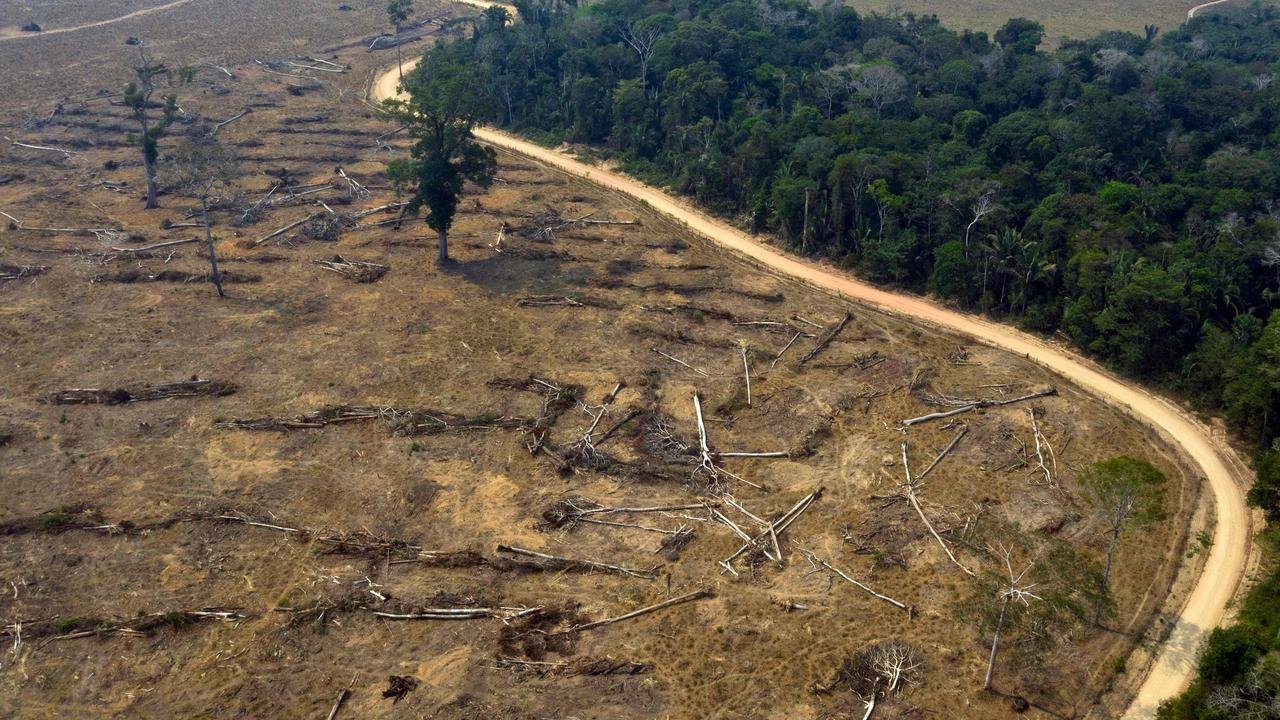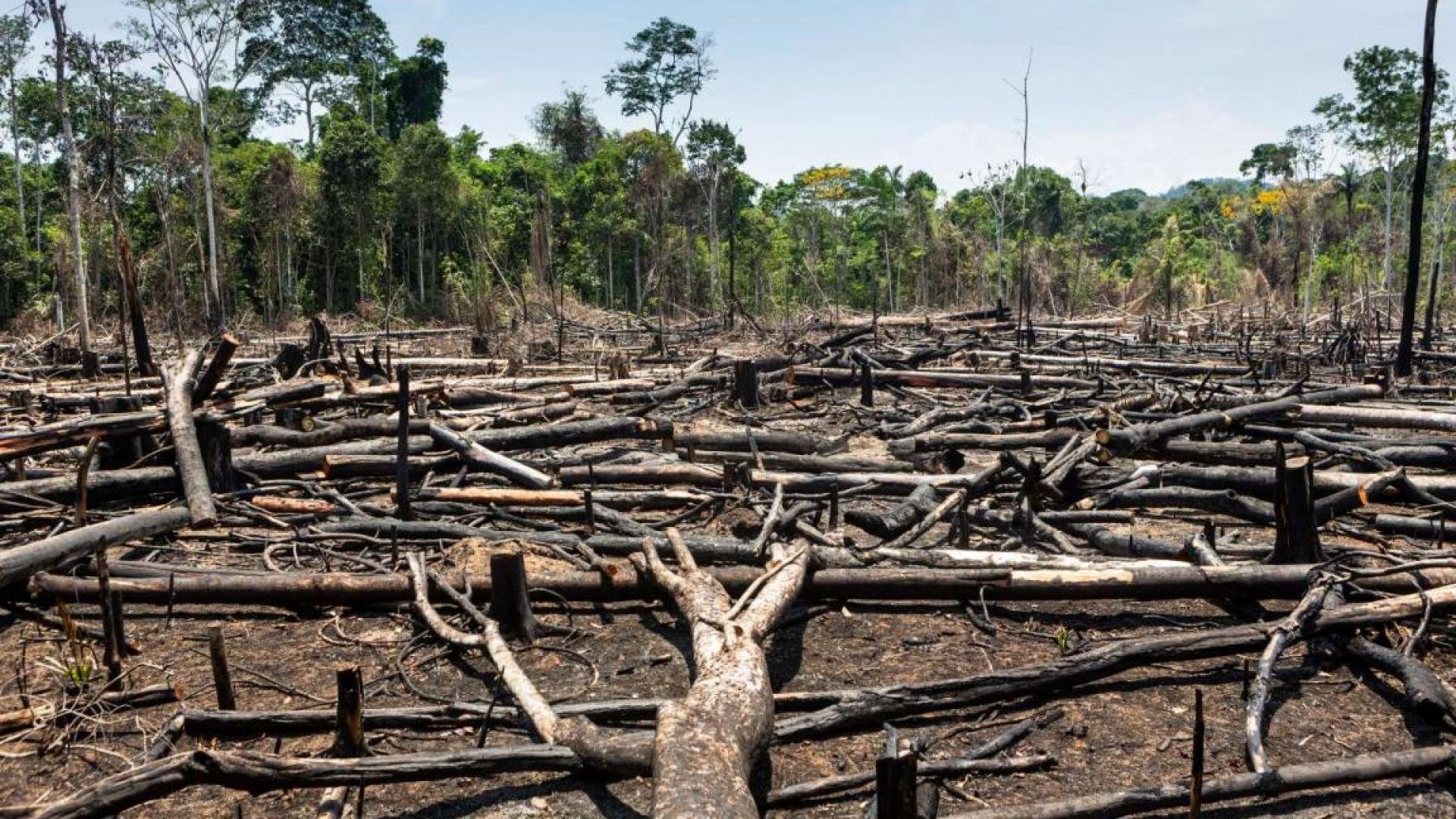How leather supply chains around the globe are tied to deforestation
Image: Leonardo Carrato / Bloomberg // Healthy vegetation sits alongside a field scorched by fire in the Amazon rainforest.
Most people interested in fashion and sustainability have heard the industry claims that leather is the more sustainable option as it is ‘natural’. However, global leather supply chains are responsible for the destruction of the natural world, including through deforestation.
Where does leather come from?
Leather is a valuable ‘co-product’ of the meat industry, meaning that cows who are bred and killed for ‘beef’ are also exploited for their skins, transformed into leather for a profit. As many are already aware, raising cattle for agriculture, which includes leather production, is linked to catastrophic sustainability issues like deforestation, biodiversity loss, greenhouse gas emissions, and water waste. For now, let’s talk about deforestation.
Leather’s destruction of the Amazon Rainforest
In Brazil, land clearing to raise cattle killed for food and fashion is responsible for 80% of the Amazon’s deforestation. This devastating industry wreaks havoc because it is fundamentally inefficient and unsustainable to rear animals as products.
In order to produce less than nine leather jackets, one hectare of land in Brazil must be cleared or kept cleared. It is likely this land was cleared illegally, and that it was taken from the biodiverse Amazon Rainforest. One acre of land is also required to produce 10 leather bags, or 17 pairs of leather boots. That is 15 tennis courts worth of land! It’s even more shocking when we take into account that 20% of leather will be wasted in the production process — meaning that all that land use and environmental damage will end up as scraps on the production floor.
Research has shown that the cattle industry is the single largest driver of deforestation in the Amazon rainforest and the fashion industry is a powerful driver of the leather exportation system. Despite these impacts, this business continues because the Brazilian industry profits greatly from leather sales as a leading producer.
Image: Carlos Fabal /AFP // Steady deforestation means the Amazon rainforest is losing its ability to recover and could permanently turn into savanna.
Leather, deforestation and habitat destruction globally
While some brands have moved their leather supply chains away from Brazil to protect the Amazon, deforestation is a global issue. The destruction of land for animal agriculture, and especially cattle, is widespread. Let’s take Australia as an example.
Australia is one of the top ten major cattle skin producing countries. In this country alone, cattle ranching causes a colossal 93% of deforestation in the world renowned Queensland’s Great Barrier Reef catchments, with cattle grazing the leading cause of habitat destruction across the country. This is devastating to biodiversity and the native animals endangered by this desecration.
The destruction of forests and wild vegetation leads to the direct loss of wildlife habitat. 80% of terrestrial species around the world live in forests which are often destroyed for the animal industrial complex. The world is currently undergoing the sixth great mass extinction event, which is largely due to agriculture, according to a report by the Global Forest Watch. Native animals like koalas, who are now considered endangered, suffer and lose their habitat due to animal agricultural land clearing. In Queensland and New South Wales, it is estimated that 50 million native animals die each year due to habitat loss. In turn, it is little surprise to learn that Australia has the highest rate of mammal extinction in the world.
Industry data shows some cow skin leather to be one of the most environmentally impactful material to produce when considering climate impact, fossil fuel use, water use, use of chemicals and eutrophication impacts.
How the fashion industry is dodging deforestation free laws in Europe
Animal agriculture is corrupting our soils and stands as the primary cause of deforestation, as forests are cleared to create feed crops for animals or land for them to graze on before slaughter. This has been particularly detrimental in South America, where acres of rainforest have been cleared in Brazil in order to increase land for cattle ranching and growing soy — of which 80% goes towards animal feed.
This makes it all the more perplexing to learn that the European leather industry has been peddling misinformation in a lobbying bid to escape deforestation-free law.
Planned European law intends to impose due diligence obligations for those importing and trading commodities with high deforestation risks, to ensure deforestation is not linked to goods sold in the EU. The current proposal for legislation on deforestation-free products doesn’t hold leather producers to account - in large part thanks to leather industry lobbying.
Less than a month ago, The environmental organisation Earthsight revealed that the leather industry wrote to members of the European Parliament, urging them to ensure leather trade and sales would not be impacted by deforestation-free law. The industry claimed farm-level supply chain tracing for leather was impossible, and spouted misinformation, stating deforestation was not a leather industry issue. The cattle industry also lobbied politicians at the COP26 to ensure they were not impacted by the methane emission targets. These attempts to sidestep the impact that they are having shows that these industries are refusing to take responsibility for helping to build a better world.
It’s time that the fashion industry took ownership of the destruction caused by these products and took steps to switch to sustainable (and more ethical) alternatives.
Can we replace leather in fashion?
The good news is that we’re seeing more and more research into sustainable and ethical alternatives to leather which allow people to bypass destruction, protecting animals, people and the planet. Options include cork leather, which can be harvested without harm to trees (while they continue to sequester carbon), as well as MIRUM, a plastic-free and completely bio-based option. Another alternative is Desserto, an increasingly readily available material made from native cacti plants which support biodiversity. These greener alternatives, among other sustainable innovations like pineapple leaf and mango-waste leather, provide high quality materials without the devastation of deforestation.
We cannot allow these industries, led by profit, to continue to destroy any more land. We cannot allow any more species of plants and animals to be driven to extinction for profit. The leather industry claims to be committed to sustainability and the ‘natural’, but the facts tell a different story. With so many more genuinely ethical and sustainable choices out there , why not choose them?






